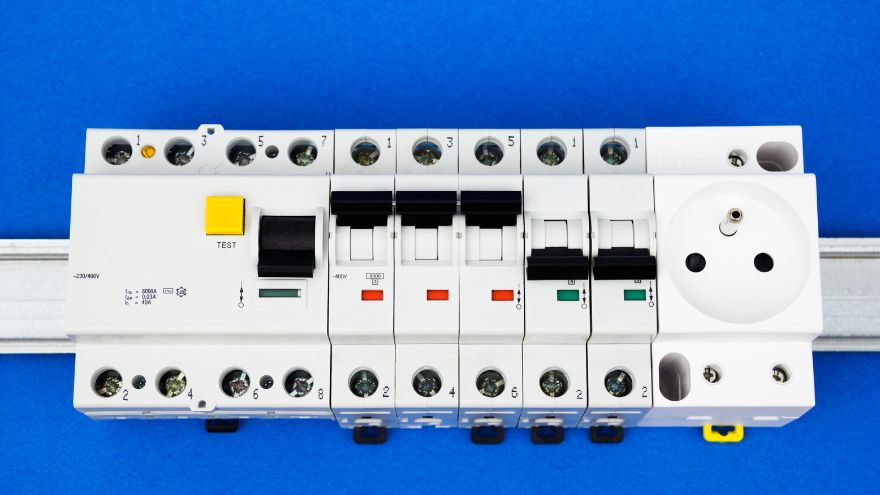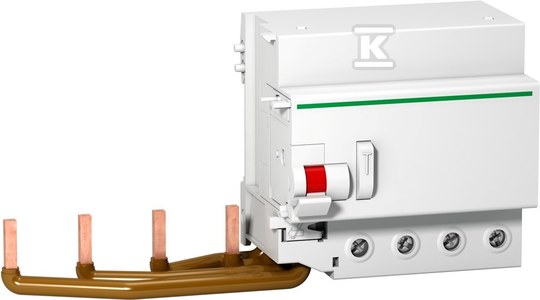Residual current circuit breakers are an important element of electrical installations. By protecting the installation and its users against electric shock, short circuit, fire and other threats, they ensure operational safety. What do you need to know about them? In the new article we write about their applications and types.

Check the residual current circuit breakers at the Onninen wholesaler
What types of residual current circuit breakers are there?
Residual current circuit breakers are the successors of fuse links and are more reliable than them. The effectiveness of the protection provided by residual current circuit breakers depends primarily on their correct selection in terms of the specificity of the installation and the type of threats against which these protective devices should protect. One of the most important aspects is choosing the right type of circuit breaker. These devices come in the following variants
Residual current circuit breakers
 They are used to protect against electric shock. They detect the difference between the current entering and leaving the circuit. There are different types available on the market, differing in sensitivity and ability to detect different types of currents.
They are used to protect against electric shock. They detect the difference between the current entering and leaving the circuit. There are different types available on the market, differing in sensitivity and ability to detect different types of currents.
Circuit breakers
Common overcurrent (short circuit) switches are designed to switch off the circuit at currents exceeding the rated value. They are classified based on their types or trigger curves.
Selective switches
These are protective devices installed in circuits before circuit breakers. In the event of a flow of currents with undesirable parameters, their function is to activate the appropriate switch - located closest to the location of the problem. The use of this type of safety device can most often be seen in industrial applications.
Grounded circuit breakers
They use grounding to control electric current and prevent electric shock. They detect stray voltage on the device housing and interrupt the circuit if the safety level is exceeded.
When is an RCD switch required?
Residual current devices are also known as RCDs (Residual Current Device). Their task is to detect any differences between the current entering and leaving the electrical circuit, which allows for immediate disconnection of the power supply in the event of improper current flow. Their operation is based on applying an incorrect current to the trigger coil. The use of RCDs is particularly important in the context of protection against electric shock. They can immediately interrupt the circuit when the long-term current carrying capacity of the wire is exceeded. This minimizes the risk of serious injury or even death from such exposure.
There are several different types of RCDs that differ in their sensitivity and ability to detect different types of currents.
- type A – they are very sensitive and trip immediately at a current exceeding 2-3 times the rated current. They are used in very sensitive electrical installations to protect electronic devices that are sensitive to fluctuations in electricity intensity;
- AC type – detect alternating residual current;
- type B – they are very versatile and are available in single- and three-phase variants. The short-circuit tripping current can be alternating, alternating and direct. B characteristic circuit breakers are used in systems where there is a risk of various types of currents, e.g. in circuits powering electronic devices.
- type C and D – designed to protect high-power devices. This group includes models with high starting currents, up to 20 times the rated current.
Check the residual current circuit breakers at the Onninen wholesaler
How to choose a circuit breaker for your home?
 The rules for selecting a current circuit breaker are regulated by the PN-HD 60364-4-43:2012 standard. The parameters of the device should be adapted to the design currents of the receivers (Ib) and the long-term current carrying capacity of the cables (Iz). The circuit breakers used should be selected in such a way that they operate not only at typical rated currents (In), but also in situations where a current flowing through them exceeds the long-term load capacity of the conductors.
The rules for selecting a current circuit breaker are regulated by the PN-HD 60364-4-43:2012 standard. The parameters of the device should be adapted to the design currents of the receivers (Ib) and the long-term current carrying capacity of the cables (Iz). The circuit breakers used should be selected in such a way that they operate not only at typical rated currents (In), but also in situations where a current flowing through them exceeds the long-term load capacity of the conductors.
When selecting a circuit breaker, the current multiplicity factor (k) should be taken into account, which is a multiple of the rated current (In). For different types of circuit breakers, such as fuses or miniature circuit breakers with characteristics B, C and D, different values of k are assumed. For miniature circuit breakers with characteristics B, C and D, k is usually 1.45. These values ensure the operation of the circuit breaker even in situations where the expected currents exceed the rated standards.
How to connect an RCBO switch?
Installing a circuit breaker is an activity that requires special caution and strict compliance with the rules. The entire process should be preceded by appropriate preparation. Before starting work, you must, of course, disconnect the main power supply in the circuit in which it will be installed. The next step is to prepare the wires that will be connected to the switch and expose the insulation at the appropriate length at the ends of the wires.
The wires should be properly connected to the switch terminals. It is important to maintain the correct order when connecting the phase, neutral and ground wires. After connecting the wires, make sure that the switch terminals are properly secured and tightened thoroughly. This prevents loose connections and the resulting problems.
Once the circuit breaker has been carefully installed and all connections are secure, main power can be restored to the circuit. This should be done carefully and under the supervision of a specialist. It is also worth testing the operation of the switch under controlled conditions.
Residual current circuit breakers in the Onninen wholesaler
At Onninen, we offer a wide selection of residual current circuit breakers. In our Onninen electrical wholesaler , you will find models that will work even in the most demanding installations and will allow you to implement complex projects. These are among others:
SCHNEIDER ELECTRIC VigiC120-4-30-AC residual current block
 A rated current of 125 A and a rated voltage of 400 to 415 V ensure versatile use of the SCHNEIDER ELECTRIC VigiC 120-4-30-AC residual current circuit breaker . The setting of the rated residual current is in the range of 0.03 to 0.03 A, so the model can be installed in various installations.
A rated current of 125 A and a rated voltage of 400 to 415 V ensure versatile use of the SCHNEIDER ELECTRIC VigiC 120-4-30-AC residual current circuit breaker . The setting of the rated residual current is in the range of 0.03 to 0.03 A, so the model can be installed in various installations.
EATON FRCdM residual current circuit breaker
The rated voltage of this circuit breaker is 415 V and the operating current of the protective device is 40 A. The small depth (70.5 millimeters) allows the installation of the EATON AC 4-pole FRCmM-40/4/003 residual current circuit breaker also in a small switchgear.
LEGRAND P304 4P residual current circuit breaker
The LEGRAND P304 4P residual current circuit breaker is available in variants with rated currents from 16 to 63 A and residual currents from 10 to 500 mA. It is equipped with a special lower hook and terminal covers to facilitate installation and is compatible with auxiliary devices (auxiliary and signaling contacts, undervoltage and shunt releases, remote drives, etc.).
Selecting the right residual current device for your home electrical installation is important to ensure its safety and effective operation. If you have any doubts, you can seek help from our team.
Check the residual current circuit breakers at the Onninen wholesaler